In the heart of Victorian Marylebone, amidst the grandeur of cobblestone streets and the rustle of silk skirts, a luminous soul graced the world with her presence. Born into a tapestry of opulence and boundless love, Edith Cameron Willats emerged as a jewel in the crown of a family both large in number and steeped in prosperity. As the crisp London air enveloped her in those early days of 1861, one could almost sense the promise of greatness that danced in her bright, curious eyes. The Willats clan, an embodiment of affluence and stature, cradled young Edith in a cocoon of privilege, where each day held the promise of enchantment and opportunity. In a household where I imagine laughter echoed off the polished walls and the scent of lavender lingered in every room, Edith’s days unfurled like pages from a cherished storybook. Her family, a constellation of characters with hearts as vast as their fortunes, ensured that her world was a sanctuary of warmth, wisdom, and wonder. In the heart of this bustling district, where the symphony of horse-drawn carriages harmonized with the pulse of urban life, Edith’s footsteps echoed in time with the heartbeat of a city in metamorphosis. Marylebone, a portrait of elegance and sophistication, served as the backdrop to her earliest adventures and with each passing season, the young Edith bloomed, a delicate flower nurtured by the love and legacy of generations. As I delve into the pages of history, I uncover fragments of her existence through documents penned with ink that has long since dried, each one uncovers secrets only whispered to those who listen closely. Each piece tells a story, and each story reveals a layer of Edith’s spirit. Please join me, as we embark on a journey through the sepia-toned corridors of time, unraveling the story of Edith Cameron Willats, a luminous soul who once graced the cobbled streets of Victorian Marylebone. Through the echoes of laughter, the rustle of silk, and the whispered promises of yesteryears, we’ll come to know the heart of a young woman whose life continues to illuminate our family’s history. Let’s walk the cobblestones of Marylebone, stand beneath the same skies that witnessed her life unfold, and peer into the windows of history to glimpse the soul of my 3rd great Grandaunt, Edith Cameron Willats.

Welcome to the year 1861, England.
Queen Victoria was in the 24th year of her reign, having ascended to the throne in 1837. England was in the midst of the Industrial Revolution, a period of rapid industrialization, technological advancement, and urbanization. Factories and mechanized production were transforming the economic landscape. England was a society deeply stratified by class. The upper classes, including the aristocracy and wealthy industrialists, lived in opulence, while the working class faced challenges related to working conditions and poverty. Cities were growing at an unprecedented rate, with London being the largest and most influential. This urban expansion led to issues like overcrowding, sanitation problems, and public health concerns. The political landscape was marked by the dominance of the Conservative Party, led by Lord Palmerston. The Liberal Party, under leaders like William Gladstone, was gaining momentum and would eventually play a pivotal role in later decades. England was a global superpower, with a vast colonial empire that spanned continents. The British Empire’s influence was felt in regions as far-reaching as India, Africa, and the Caribbean. Across the Atlantic, the United States was embroiled in the American Civil War (1861-1865). England closely followed this conflict due to its economic ties with the United States, particularly in the cotton industry. The arts flourished during this period. Charles Dickens, a prominent English writer, was publishing some of his most famous works. The Pre-Raphaelite Brotherhood, a group of artists, was making waves in the art world. The 1860s saw increased efforts toward education reform and the expansion of educational opportunities for all social classes. Social activists like Florence Nightingale were advocating for improvements in healthcare. The mid-19th century was a time of significant public health concerns. Issues like inadequate sanitation and the spread of diseases were becoming increasingly apparent, prompting calls for reforms. Photography was gaining popularity, providing a new medium for documenting society and daily life. Newspapers and journals played a crucial role in disseminating information and shaping public opinion. There were many notable births in 1861, Maurice Hewlett, historical novelist, poet and essayist, Sidney Jones, musical comedy composer, William Burrell, Scottish shipowner and art collector, Frederick Hopkins, biochemist, recipient of the Nobel Prize for Physiology or Medicine, Lionel Monckton, musical comedy composer, Agnes Jekyll, née Graham, artist, writer on domestic matters and philanthropist, William Burrell, Scottish shipowner and art collector.
And our very own, Edith Cameron Willats, was born on Sunday the 20th of October, 1861, at 34 Charlotte Street, Marylebone, Middlesex, England, to Mr. Richard Henry Willats and Mrs Eliza Willats nee Cameron. Richard Henry, registered Edith’s birth on Monday the 25th of November, 1861, in Marylebone. He gave his occupation as a Commercial Traveller and their abode as, Number 34 Charlotte Street, Marylebone. Edith joined a family of 6, her parents Richard and Eliza, and four siblings, William George, Henry Richard, Francis Montague Allan and Charlotte Ellen Willats.

Marylebone (usually /ˈmɑːrlɪbən/, also /ˈmærɪləbən, ˈmærɪbən/) is a district in the West End of London, in the City of Westminster. Oxford Street, Europe’s busiest shopping street, forms its southern boundary. An ancient parish and latterly a metropolitan borough, it merged with the boroughs of Westminster and Paddington to form the new City of Westminsterin 1965. Marylebone station lies two miles north-west of Charing Cross. There are also two tube stations in Marylebone – Baker Street and Bond Street. Marylebone was originally an Ancient Parish formed to serve the manors (landholdings) of Lileston (in the west, which gives its name to modern Lisson Grove) and Tyburn in the east. The parish is likely to have been in place since at least the twelfth century and will have used the boundaries of the pre-existing manors. The boundaries of the parish were consistent from the late twelfth century to the creation of the Metropolitan Borough which succeeded it.
Living in Marylebone, London, England, during the 1860s and onwards was an experience deeply intertwined with the rapid changes and urbanization that characterized the Victorian era. Marylebone is an affluent district located in the heart of London, known for its Georgian architecture, charming streets, and elegant squares. During the 1860s, it was transitioning from a primarily residential area to a more commercial and cosmopolitan hub. Marylebone housed a diverse socio-economic population. On one hand, you had the affluent upper classes residing in grand townhouses, while on the other, there were working-class families, artisans, and tradespeople inhabiting smaller dwellings or apartments. Horse-drawn carriages were the primary mode of transportation, both for personal use and public transport. The advent of railways was transforming London’s accessibility, connecting the city to distant suburbs. Education was becoming more accessible. Elementary schools were established for children of all classes, and private tutors were available for wealthier families. For higher education, institutions like the University of London were accessible. Marylebone was home to a mix of industries. While the wealthier residents might be engaged in commerce, law, or politics, the working-class population found employment in local shops, markets, or as domestic servants. The district offered a range of cultural and leisure activities. Theatres, music halls, and galleries provided entertainment for the upper classes, while pubs, music venues, and local events catered to the working-class community. Healthcare was undergoing improvements. Hospitals and dispensaries were established, although the quality of care varied significantly based on one’s social status. Victorian society was characterized by strict social norms and expectations, particularly regarding gender roles and behavior. The upper classes adhered to a more rigid code of conduct, while the working class often had a different set of social dynamics. Sanitation was a major concern. The 1860s saw the beginning of sanitation reforms, aiming to improve public health and combat issues related to overcrowding and unsanitary living conditions. The 1860s witnessed various historical events, including the American Civil War, which had economic implications on Britain, and the emergence of the women’s suffrage movement, challenging traditional gender roles. The latter half of the 19th century marked a period of significant change in Marylebone and London as a whole. The city was rapidly expanding, and advancements in technology, industry, and transportation were reshaping the urban landscape. Living in Marylebone during this period meant experiencing the juxtaposition of tradition and modernity, as the district played its part in the evolving narrative of London’s history. It was a time of both challenges and opportunities, where individuals navigated the shifting sands of a rapidly changing society.
Just under two years later, Edith’s brother, Arthur Charles Willats, was born on Saturday, the 11th of July, 1863, at Number 37, Charlotte Street, Marylebone, Middlesex, England. Their father, Richard Henry registered Arthur’s birth on Friday the 21st of August, 1863. Richard’s occupation was given as a, Commercial Traveller and their abode as Number 37, Charlotte Street, Marylebone.

Edith Cameron and Arthur Charles Willats, were baptised on Sunday the 9th of August, 1863, at Holy Trinity Church, Marylebone Road, Westminster, Middlesex, England. Richard’s occupation was given as a Traveller and their abode was Number 37, Charlotte Street.

Edith, welcomed another new brother, on Friday the 13th of January 1865. Eliza and Richard, named him, Walter James Willats. Eliza gave birth at their home, 37, Charlotte Street, Marylebone, All Souls, Middlesex, England. Richard registered Walters birth on Thursday the 9th of March 1865. He gave his occupation as a commercial traveller and their abode as, 37, Charlotte Street.

Edith’s brother Walter James was baptised on Sunday the 26th of February, 1865, at Holy Trinity Marylebone Road, Marylebone, Middlesex, England. Richards’s occupation was given as a commercial traveller and their abode was given as Number 37 Charlotte Street.

Edith’s parents Richard Henry Willats and Eliza Willats nee Cameron finally decided to marry. Their banns were read, at St John the Evangelist, Smith Square, London, England, on the Sunday the 9th and Sunday the 16th of April, by W.S. Bruce and again on Sunday the 23rd of April, 1865, by J. Graham.

St John’s Smith Square is a redundant church in the centre of Smith Square, Westminster, London. In 1710, the long period of Whig domination of British politics ended as the Tories swept to power under the rallying cry of “The Church in Danger”. Under the Tories’ plan to strengthen the position of the Anglican Church and in the face of widespread damage to church buildings after a storm in November 1710, Parliament concluded that 50 new churches would be necessary in the cities of London and Westminster. An Act of Parliament in 1711 levied a tax on coal imports into the Port of London to fund the scheme and appointed a commission to oversee the project. Archer was appointed to this commission alongside, amongst others, Hawksmoor, Vanburgh and Wren. The site for St. John’s was acquired from Henry Smith (who was also Treasurer to the Commissioners) in June 1713 for £700 and building commenced immediately. However, work proceeded slowly and the church was finally completed and consecrated in 1728. In total, the building had cost £40,875. The church was built by Edward Strong the Younger a friend of Christopher Wren the Younger.
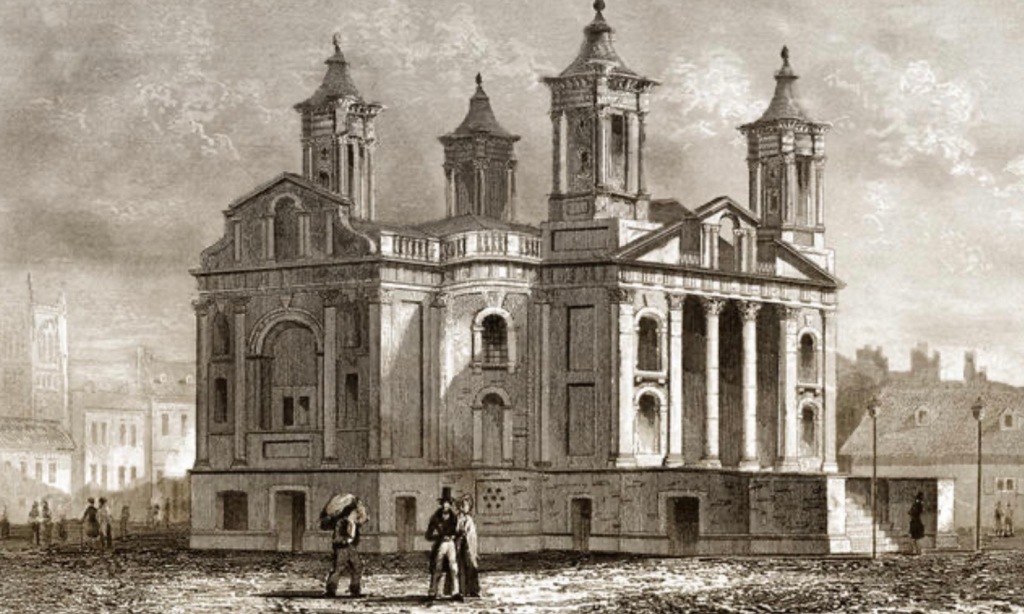
Ediths parents Mrs. Eliza Willats nee Cameron, and Mr. Richard Henry Willats married on Thursday the 4th of May, 1865, at, St Margarets, Westminster, London, England. Richard was a Bachelor. Eliza was listed as a widower, which is rather strange as her first husband George John Willats (Charlotte’s uncle/Richard Henry Willats brother) was one of their witnesses and didn’t die until later that year. Their other witness was, Edith’s Aunt/Eliza’s sister, Mary Cameron. Eliza and Richard, were residing at 10 North Street. Richard was working as a, Commercial Traveller. Eliza’s Father, Allen Cameron was working as a Tailor and Richard’s Father, George John Willats, was working as a Wood Craver. As I have mentioned many times before (sorry), I have no idea as to how Richard and Eliza were able to marry, as it was strictly forbidden to marry a brothers wife even a deceased brother. Family story’s state that, a sympathetic member of the clergy came to their rescue and had the first marriage annulled. I guess we will never know for sure but it seems that maybe something fishy was going on as George John married Sarah Elizabeth Southall Jukes, in Victoria, Australia, in 1856 (11 years before Richard and Eliza wed.

St. Margaret’s, known as ‘the Church on Parliament Square’, is a 12th-century church next to Westminster Abbey. It’s also sometimes called ‘the parish church of the House of Commons’. The Church of St Margaret, Westminster Abbey, is in the grounds of Westminster Abbey on Parliament Square, London, England. It is dedicated to Margaret of Antioch, and forms part of a single World Heritage Site with the Palace of Westminster and Westminster Abbey. The church was founded in the twelfth century by Benedictine monks, so that local people who lived in the area around the Abbey could worship separately at their own simpler parish church, and historically it was within the hundred of Ossulstonein the county of Middlesex. In 1914, in a preface to Memorials of St. Margaret’s Church, Westminster, a former Rector of St Margaret’s, Hensley Henson, reported a mediaeval tradition that the church was as old as Westminster Abbey, owing its origins to the same royal saint, and that “The two churches, conventual and parochial, have stood side by side for more than eight centuries – not, of course, the existing fabrics, but older churches of which the existing fabrics are successors on the same site. In 1863, during preliminary explorations preparing for this restoration, Scott found several doors overlaid with what was believed to be human skin. After doctors had examined this skin, Victorian historians theorized that the skin might have been that of William the Sacrist, who organized a gang that, in 1303, robbed the King of the equivalent of, in modern currency, $100 million. It was a complex scheme, involving several gang members disguised as monks planting bushes on the palace. After the stealthy burglary 6 months later, the loot was concealed in these bushes. The historians believed that William the Sacrist was flayed alive as punishment and his skin was used to make these royal doors, perhaps situated initially at nearby Westminster Palace. Subsequent study revealed the skins were bovine in origin, not human.
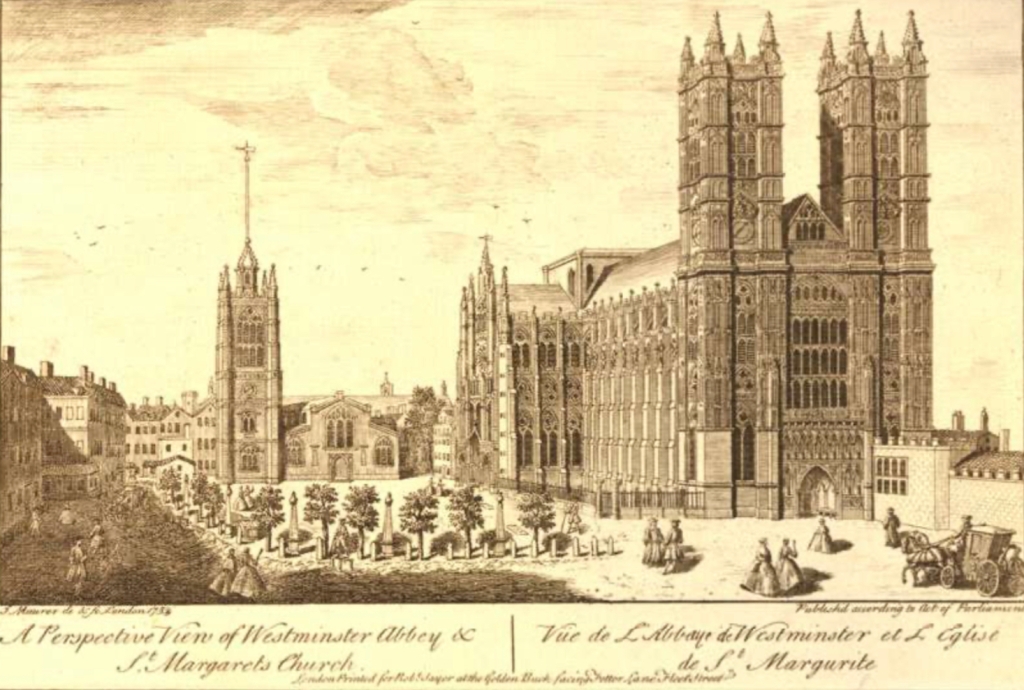
Edith’s sister, Eliza Mary Willats, was born on Wednesday the 20th of March, 1867, at Number 37 Charlotte Street, All Paul’s, Marylebone, Middlesex, England. Their Father Richard was working as a Buyer of Diamonds, at the time of her birth. Eliza registered Eliza’s birth on Monday the 29th of April 1867. Eliza Mary was known as Polly.

Edith and her rather large family were residing at Number 37 Charlotte Street, All Paul’s, Marylebone, Middlesex, England, on Sunday the 21st of April 1867, when her sister Eliza Mary Willats was baptized at Holy Trinity Church, Marylebone Road, Marylebone, Middlesex, England. Richards’s occupation was given as a Salesman and their abode was, 37 Charlotte Street.
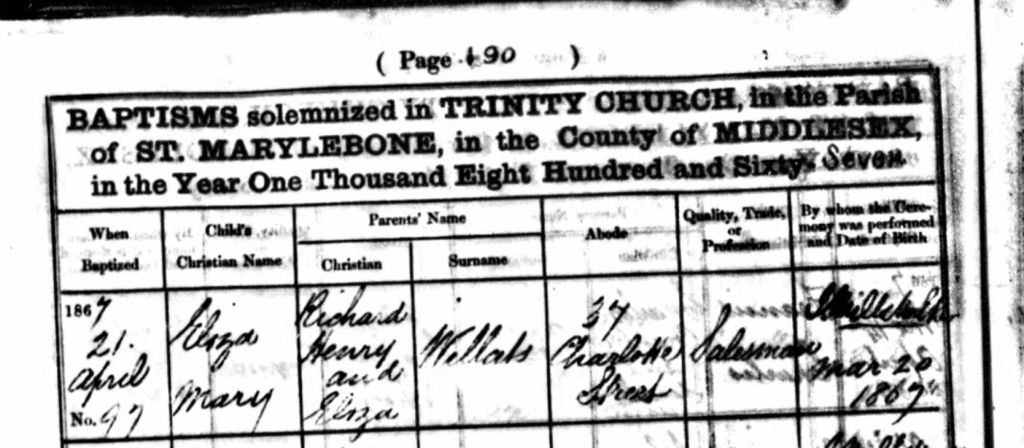
Edith’s sister, Lilly Jenny Willats, was born on Monday the 4th of October, 1869, at, Number 38, Regent Square, Greys Inn Lane, Pancras, Middlesex, England. Lily’s mother Eliza Willats nee Cameron, registered her birth on Saturday the 15th of January 1870. She gave Lily’s Father Richard Henry Willats, whose occupation was listed as a Traveller ( Feathers) and their abode as Number 38, Regent Square, Pancras.

Regent Square is a public square and street in the London Borough of Camden in London, England. It is located near Kings Cross and Bloomsbury. Regent Square was laid out around a large garden in the historic Harrison Estate and first occupied in 1829, forming a garden square similar to more famous ones to the west in Bloomsbury. The southern side of the square is composed of its original buildings, and is Grade II listed in its entirety. Also listed is the phone box within the square gardens themselves.
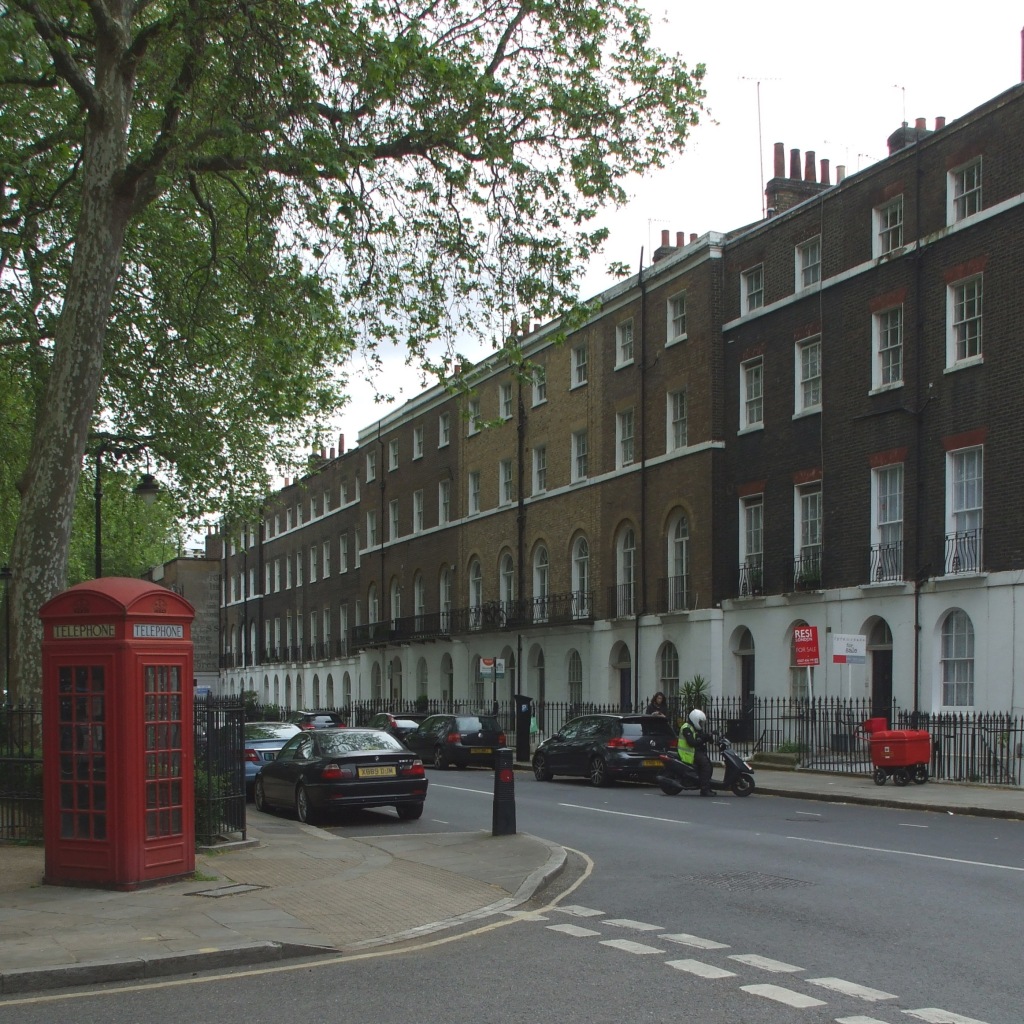
Edith and her family, baptized Lily Jenny Willats, on Sunday the 31st of October, 1869, at Saint Peter Church, Saint Pancras, London, England. It was a private baptism. Her baptism shows that Richard was working as a Warehouse Man and their abode was, Number 38, Regent Square.

Saint Peters church, in Regent Square was hit by bombs in the war and had to be demolished. Unfortunately there doesn’t seem to be much information about it online. From the below image, it was a very impressive building.

The 1871 census was taken on Sunday 2nd April 1871, it shows us, that Edith, her parents Richard, and Eliza, and her siblings, Walter, Henry, Eliza, Lillian, Charlotte, George and Francis, were residing at, Number 5, Park Road, Islington, Middlesex, England, Richard was working as a Dealer in feathers. The family had two General Servants, residing with them, Jemima Roack and Caroline Curry.
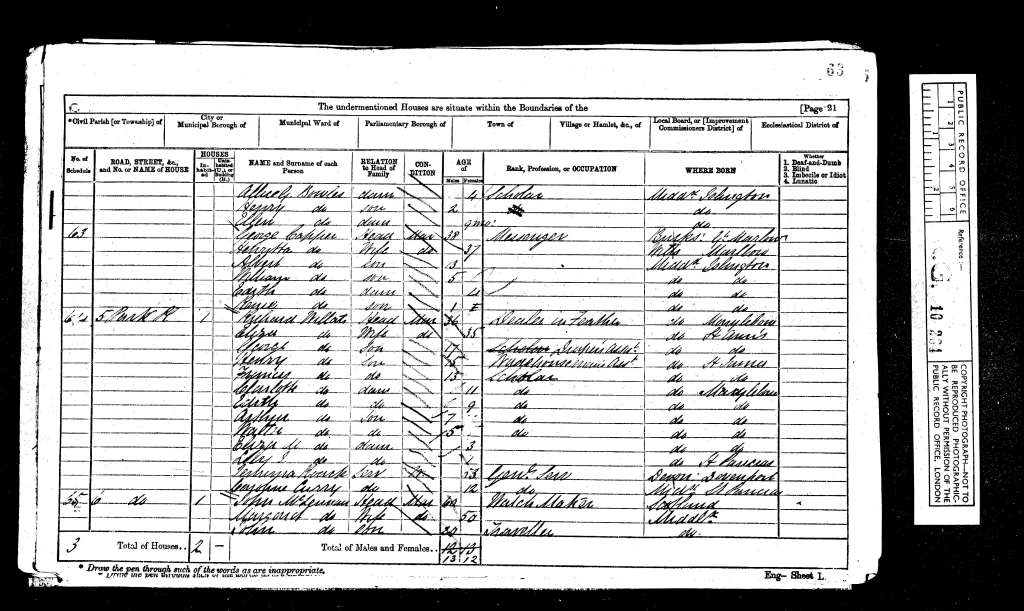
5 Park Place, London is a 3 bedroom freehold terraced house – it is ranked as the 3rd most expensive property in N1 3JU, with a valuation of £1,432,000. Since it last sold in July 2016 for £1,450,000, its value has decreased by £18,000. It is now a sleek contemporary townhouse within a private gated mews, arranged over three floors with an allocated parking space.
Edith’s brother, Edwin Paul Willats, was born on Wednesday the 8th of November, 1871, at Number 5, Park Place, Highbury, Islington, Middlesex, England. Edwin father Richard Henry Willats, registered Edwins birth on Wednesday December 20th 1871. He gave his occupation as a Commercial Buyer and their abode as, Number 5, Park Place, Islington.

Edwin Paul, was baptised on Friday the 8th December 1871, at the Parish Church of St Mary the Virgin, Islington, Middlesex, England. Richards occupation was listed as a, Workhouse Man and their abode as 5 Park Place.

The Church of St Mary the Virgin is the historic parish church of Islington, in the Church of England Diocese of London. The present parish is a compact area centered on Upper Street between Angel and Highbury Corner, bounded to the west by Liverpool Road, and to the east by Essex Road/Canonbury Road. The church is a Grade II listed building.
The churchyard was enlarged in 1793. With the rapid growth of Islington, it became full and closed for burials in 1853. It was laid out as a public garden of one and a half acres in 1885.

Edith’s sister, May Claretta Willats, was born on Tuesday the 5th of May, 1874, at 5 Park Place, Highbury, East Islington, England.
May’s father Richard Henry Willats registered May’s birth on Tuesday the 16th of June 1874. He gave his occupation as a Feather Warehouseman and their abode as 5 Park Place, Islington.

May Claretta, was baptised on, the 9th of August, 1874, at Christ Church, Highbury, Islington, Middlesex, England. Richard gave his occupation as a Manufacturer and their abode as, Highbury. Christ Church, Highbury, is an Anglican church in Islington, north London, next to Highbury Fields.

Christ Church, Highbury is an Anglican church in Islington, north London, next to Highbury Fields.
The site was given by John Dawes, a local benefactor and landlord, and the church was built by Thomas Allom in a cruciform shape with a short chancel, transepts, and nave from 1847 to 1848. Bridget Cherry and Nikolaus Pevsner write that Christ Church Highbury ‘is a successful and original use of Gothic for a building on a cruciform plan with broad octagonal crossing. The cross-plan with broad nave and crossing were popular for churches in the low church tradition where an effective auditorium for the spoken word was preferred to a plan designed for an elaborate liturgy.’
Since then, several changes have been made to the church, including the addition of a balcony in 1872, and new rooms for children’s work and fellowship in 1980.
The church was opened in 1848 by Reverend Matthew Anderson Collisson, son of Irishman Daniel Marcus Collisson and his wife Catherine.
A special service booklet was published to celebrate the occasion: “On the Consecration of the New Church at Highbury, Dedicated to the Saviour as ‘Christ’s Church'”, Reverend M A Collisson.

Edith’s brother, Percy Sidney Willats was born on Wednesday the 1st of September 1875, at Number 9, Park Place, Highbury, Islington, Middlesex, England. Their father Richard Henry Willats, registered Percy’s birth on Saturday the 9th October, 1875, in Islington. He gave his occupation as a, Fancy Warehouseman and their abode as, 9, Park Place, Islington.

Edith’s Sister, Charlotte secretly married by licence a young Bachelor named Peirce William Crosbie, on the 11th of January 1876, at St Mary Church, Islington, Middlesex, England. They both stated they were of full age, even though Charlotte was only 16. Their witnesses were, Henry Billey and Henry Smith. Charlotte gave her abode as, 9 Park Place and Pierce gave his As 9 Riverdale Road. Pierces occupation was given as a Clark. They gave their fathers names and occupations as, Richard Henry Willats, a Warehouseman and John Crosbie a Gentu.

I wonder why they got married in secret? The family obviously were not happy about the secret marriage and Charlotte Ellen Willats married, Pierce William Crosbie, for a second time, this time not in private. They married on Tuesday the 28th of March, 1876, in St Mary’s Church, Islington, Middlesex, England. Charlotte was a minor and Pierce was of full age. Their relationship status were given as Spinster and bachelor. Pierces occupation was given as a Gentu. They gave their residence as 9 Park Place and gave their fathers names and occupations as, Richard Henry Willats, a Warehouseman and John Crosbie a Gentu. Their witnesses were Richard Willats and Charlottes future sister in-law Margaret Jane McLennon.
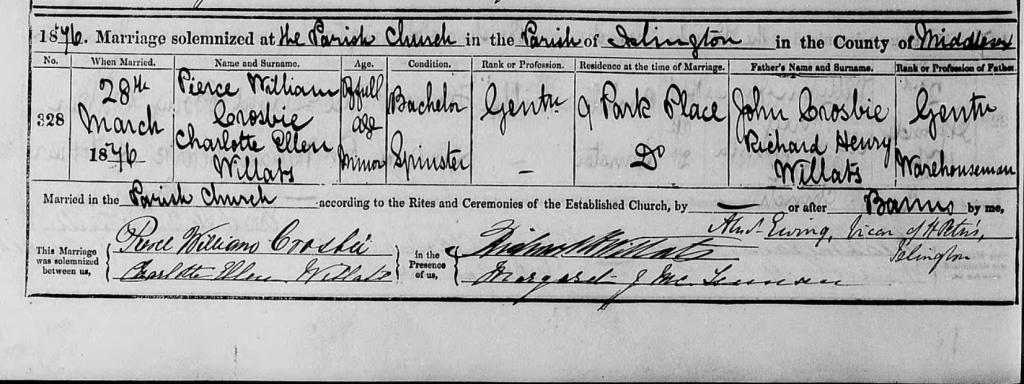
Edith’s brother, Frederick Howard Willats was born on on Tuesday the 27th of February 1877 at, Number 9, Park Place, Highbury, Islington, Middlesex, England. His father Richard Henry Willats registered Frederick’s birth on Saturday the 10th March 1877. Richard gave his occupation as a Silk Warehouseman, and their abode as, 9 Park Place, Islington.

Edith’s brother 24-year-old, bachelor, and publican, Henry Richard Willats married 23 year old, spinster, Amelia Etheredge, daughter of John Etheredge, on Tuesday the 30th of March, 1880 at All Saints Church, West Ham, Essex, England. Henry gave his residence as West Ham and Amelia as, Saint Paul’s, Shadwell. They gave their fathers names and occupations as, Richard Henry Willats, a Licensed Victualler and John Etheredge, an Engineer. Their witnesses were Charles Henry Etheredge and Alice Catherine Etheredge.

A few short months later, it was Edith’s turn to walk down the aisle. 19-year-old, spinster, Edith Cameron Willats married 21-year-old Bachelor, Edward Charlton, an Esquire, on Wednesday the 20th of October, 1880, at St Margaret Church, George Hanover Square, Westminster, London, England. They gave their fathers names and occupations as, Richard Henry Willats, a Hotel Keeper and Henry Charlton, a Hotel Keeper. Edith gave her residents as, 20 Australian Avenue, Barbican, Silk Street, St Giles, Westminster, London, EnglandAnd Edward gave his as Westminster Palace Hotel. Their witnesses were, Richard Willats and William Charlton.

The 1881 census was taken on Sunday the 3rd of April, 1881. It shows Edith, and her husband Edward were residing at Number 106 St. Thomas Road, Highbury, Islington, Middlesex, England.

They had 9 year old, Jenny Keep, visiting them and a domestic servant, Phobie Woods working and residing with them. Edward gave his occupation as an ex-licenced Vic. Jenny was a scholar.
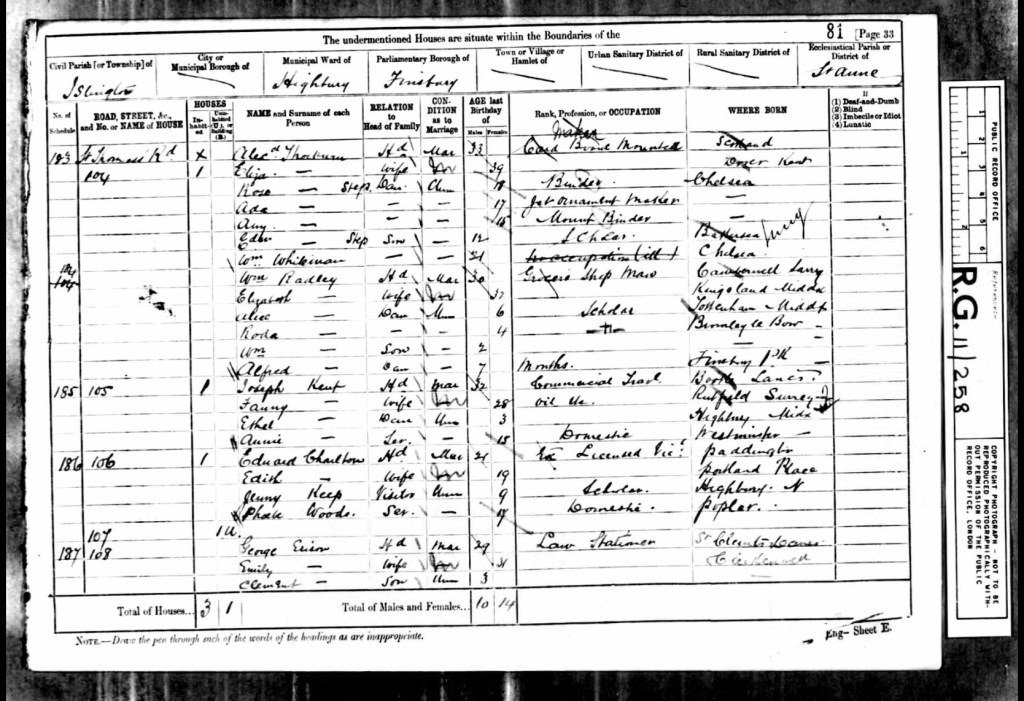
Edith’s brother 23-year-old, bachelor, Francis Montague Allen Willats, married 25-year-old, spinster, Margaret Jane McLennon, at St John’s Church, Hornsey, Middlesex, England, on Wednesday the 6th of July, 1881. Francis was working as an agent at the time of his marriage. They gave their fathers names and occupations as Richard Henry Willats, an Agent and John McLennon, a Chronometer Maker. Francis gave his abode as, 145 Blackstock Road and Margaret gave hers as, 84, Finsbury Park Road. Their witnesses were John McLennon and Jessie McLennon.

Edith and Edwards’s daughter, Amina Eliza Catherine Charlton, was born on Saturday the 28th of January, 1882, at their home, Number 41 Victoria Road, Upper Tollington Park, Hornsey, Middlesex, England.
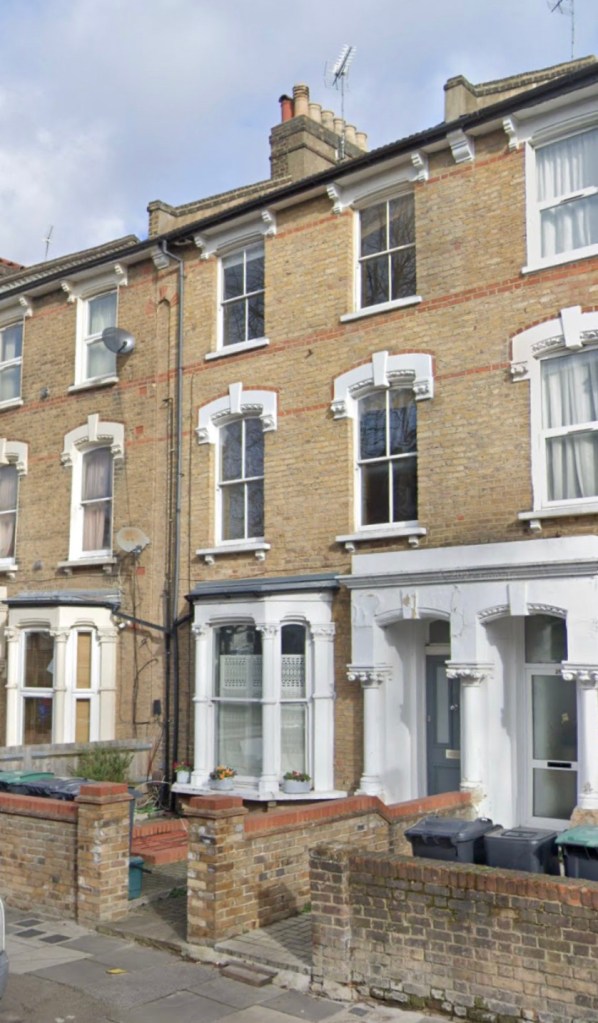
Edith’s husband Edward, registered Amina’s birth in Edmonton, on the 6th March 1882. He gave his occupation as a Land Surveyor and their abode as Number 41 Victoria Road, Upper Tollington Park, Hornsey.

Edith’s brother 29-year-old, bachelor William George Willats, a Commercial Traveller, married 27-year-old spinster, Alice Maria Money, at The Register Office, Islington, Middlesex, England, on Saturday the 23rd of December, 1882. William gave his occupation as a Commercial Traveller. They gave their fathers names and occupations as, Richard Henry Willats, an Auctioneer, and John Money (deceased) a Builder. Their witnesses were, Eliza Willats and Amelia Willats.
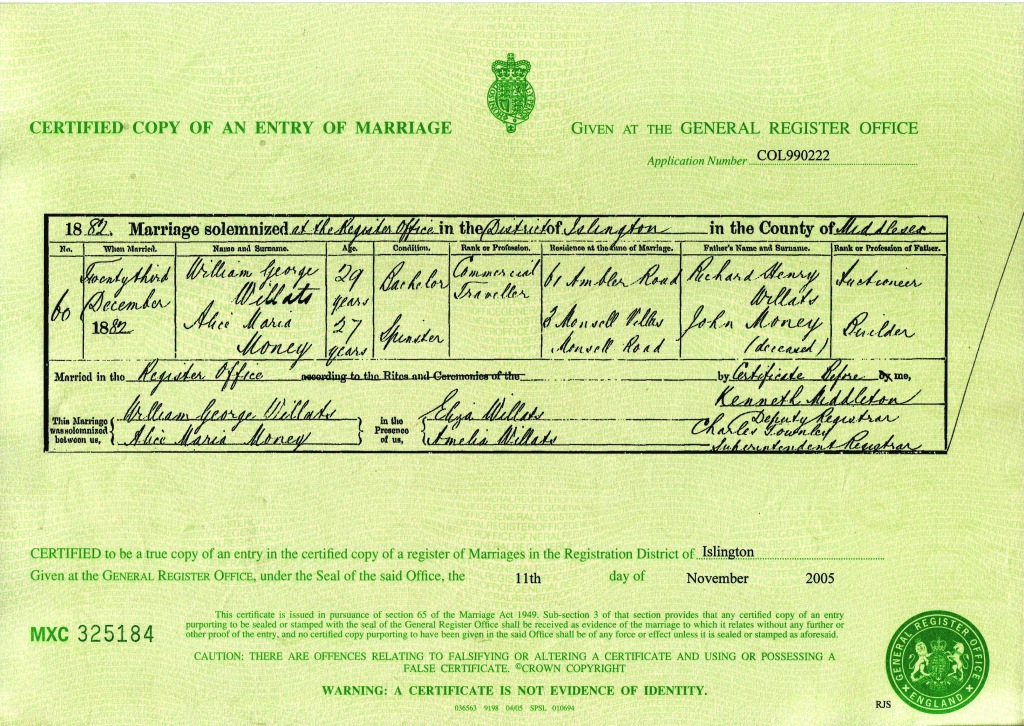
Edith and Edward’s son, Francis Henry Arthur Charlton, was born on Monday the 26th of March 1883, at 2 Warden Villas, Ambler Road, Islington, Middlesex, England. Edith’s husband Edward, registered Francis’s birth on Tuesday the 17th of April 1883 in Islington, Middlesex, England. He gave his occupation as a land surveyor and their abode as, 2 Warden Villas, Islington.

Edith and Edward, baptized their son, Francis Henry Arthur Charlton on the 21st of December 1883, at St Ann, St Thomas, Islington, Middlesex, England. Edward gave his occupation as a surveyor and their abode as, 61 Ambler Road.

Across the pond in Buffalo United States of America, Edith’s brother Arthur Charles Willats married Josephine Mary Conley in 1886 when he was 23 years old. Unfortunately at present I haven’t come across any documentation for their marriage only census records and births of their children. Being in the United Kingdom, research in America isn’t the easiest especially ordering certificates etc.
Jumping forward to the year 1891, Queen Victoria was in the 54th year of her reign. The Industrial Revolution had transformed England into a leading industrial power. Large factories and urban centers continued to grow, leading to both economic prosperity and challenges related to living conditions and worker’s rights. The British Empire, which included territories across the globe, ensured England’s economic dominance. Industries like textiles, steel, and shipbuilding were thriving, contributing to the nation’s wealth. The Liberal Party, led by William Gladstone, was in power at the beginning of 1891. Later in the year, Lord Salisbury’s Conservative Party took over after the general elections. England’s society remained stratified by class. The upper classes maintained their privileged positions, while the working class and lower middle class were becoming more organized in their efforts to advocate for workers’ rights. The late 19th century was a period of artistic flourishing, with the Aesthetic Movement and the Arts and Crafts Movement gaining prominence. Writers like Oscar Wilde and artists like William Morris were influential figures. Efforts to expand education and improve healthcare continued. Compulsory elementary education was introduced, and the foundation for modern healthcare systems was being laid. The late 19th century saw significant strides in the women’s suffrage movement. Women were increasingly vocal about their rights and their desire for greater political representation. The period witnessed important scientific developments, including the discovery of X-rays by Wilhelm Roentgen in 1895 and the increasing understanding of genetics and evolution. The railway network was well-established, facilitating both domestic travel and the transportation of goods. Horse-drawn vehicles were still common in cities, but automobiles were on the horizon. The British Empire was at its zenith, with colonies spanning continents. England’s imperial interests were vast, and the empire’s influence extended to regions across Asia, Africa, and the Americas. Leisure activities included attending theaters, music halls, and sporting events. The popularity of team sports like football (soccer) was on the rise. The late 19th century saw ongoing innovations in technology. The development of electric power, telephone communication, and improvements in transportation were reshaping daily life.
And on Sunday the 5th of April 1891, the United Kingdoms census was held, It shows that Edith, Edward and their children, Amina E K and Fransis Henry Arthur Charlton, were residing at, Devonshire Villas, 2, Mayes Road, Tottenham, Edmonton, Middlesex, England. They had an 18-year-old servent called Alice M Payer living with them. Edwards’s occupation was given as a Surveyor.

I found a very interesting article all about Mayes Road, Tottenham. You can find it here.
The 1891 throw a lot of confusion into my research as well as many others who are researching Edith’s life. The census shows that Francis is Edith and Edward’s daughter, Frances A K Charlton. Going off this information I searched and researched the birth indexes for a daughter but for the life of me couldn’t find a birth for a daughter only a son. Lots of people on Ancestry family trees, have Fransis as a female and married to George William Moody. I ordered their marriage certificate to confirm if I was missing something and they did indeed her a daughter whom was also called Frances as well as their son, Fransis Henry Arthur Charlton. I can confirm that Frances Ann Charlton, who married George William Moody, was in fact a widow and her maiden name was Leggeth. Her father was named as, Charles William Leggeth, a Farmer’s Market, Journeyman.

Along with the 1911 census confirming, Edith only had two children, the information from the marriage certificate and no birth index for a daughter, I can confirm that the census information about Edith and Edward having a daughter called Frances is incorrect. I have informed them and hopefully the information will be updated.
Edith’s mum, Eliza, passed away on Friday the 23rd of November 1894, at Number 27, Kings Road, South Hornsey, Edmonton, Middlesex, England, when she was 59 years old. Eliza died from, disease of valves of the heart two years nine months and dropsy. Her daughter Edith Charlton of Number 27, Kings Road, South Hornsey, was present and registered Eliza’s death on the 26th of November 1894.

Edith and her family, laid Eliza to rest, in, Abney Park Cemetery, Stoke Newington, Middlesex, England, on Thursday the 29th of November, 1894, in D06, Grave 092431. Her abode was given as, Number 27, Kings Road, Brownswood Park.

When Eliza died Edith’s father, Richard Henry, purchased 2 graves in Abney Park Cemetery, which was then the beautiful garden of a big house turned into a private cemetery. Each grave cost, 3 guineas and took six interments.

Edith’s sister, 28-year-old, spinster, Mary Eliza Willats, married 48-year-old Widower, and wine merchant, Benjamin Beach, on Thursday the 11th of July 1895, at St John’s Church, Highbury, Islington, Middlesex, England. Mary gave her residence as, 27 Kings Road and Benjamins as . (If you can work it out, please let me know.) They gave their fathers names and occupations as, Richard Beach (deceased) a Brewer and Richard Henry Willats, a Gentleman. Their witnesses were, her father Richard Henry Willats and Charles Watson.

Edith brother, 30-year-old, Bachelor, Walter James Willats, a Clark married 24-year-old spinster, Amelia Ellen High on Wednesday 21st October 1896, at the church of St Mary Magdalene, Enfield, Middlesex, England. They gave their residence at the time of their marriage as, Number 10, William Place, Chase Side, Enfield. they gave their fathers names and occupations as, Richard Henry Willats, a Suvayor and William James High, a cabinet Maker. Their witnesses were, E. F. Newcombe and S. A. Newcombe.
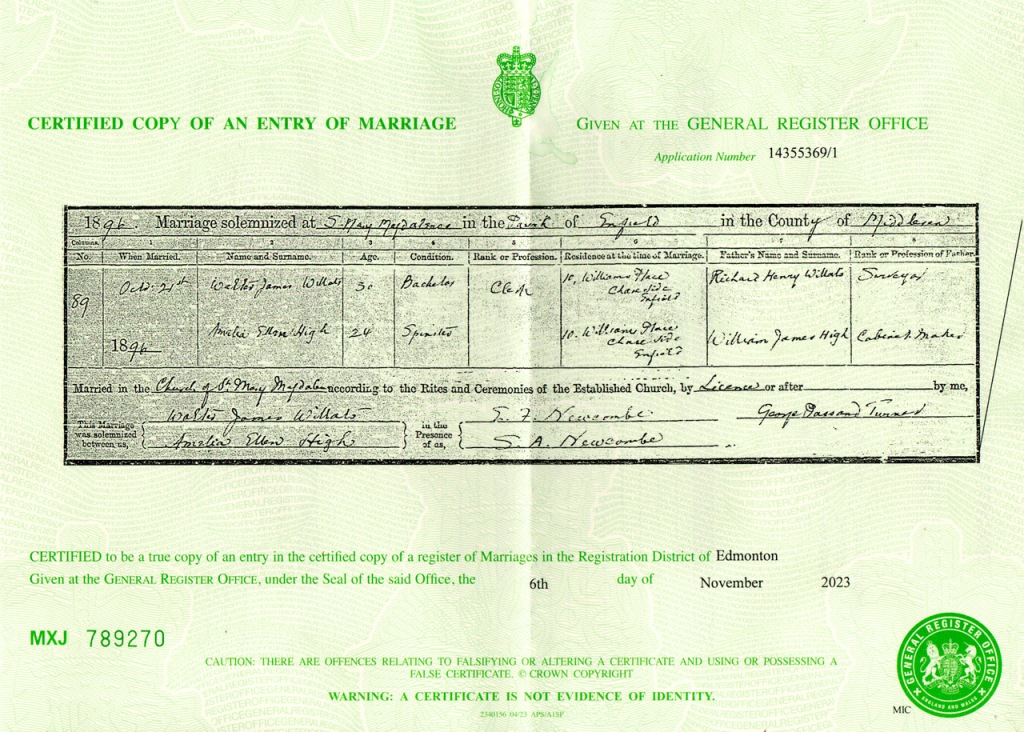
St Mary Magdalene, Enfield, is a Church of England church in Enfield, London, dedicated to Jesus’ companion, Mary Magdalene. The building is grade II* listed with Historic England. The church was built as a memorial to Philip Twells, MP and city banker, by his wife Georgiana Twells, who employed the architect William Butterfield. The foundation was stone was laid in 1881 and the church opened in 1883. The artist Charles Edgar Buckeridge painted the ceiling and east wall of the sanctuary and after his early death the side walls were painted by Nathaniel Westlake. The walls and ceiling were conserved in 2012 by Hirst Conservation with the help of local donations and the Heritage Lottery Fund. The stained-glass windows are by Heaton, Butler and Bayne.
The tower originally contained 8 change ringing bells cast by John Warner & Sons for the new church in 1883, however these were replaced in 1999, as they were too heavy for the tower and were causing damage. The church installed a new, lighter ring of 8 bells cast by the Whitechapel Bell Foundry, and the older, larger bells were bought by Grace Church Cathedral in Charleston, United States, where they were installed and augmented to 10 with two new treble bells cast in the same year, also by Whitechapel.

Heartbreakingly the Willats family lives were thrown back into the depths of grief when Edith’s brother, 43 year old, Estate Bailiff, William George Willats, my 3rd great-grandfather, died on Sunday the 14th of February, 1897, at 44 Gillespie Road, Islington, Middlesex, England. He died from Cardial Haemorrhage Corona Syncope. Their sister, Charlotte was present and registered her brother William George Willats, death on Sunday the 14th of February 1897, at Number 44, Gillespie Road, Islington, Middlesex, England. Charlotte gave her abode as, Number 132, Wilberforce Road, Finsbury Park.

Edith and family laid, William George Willats, to rest at, Abney Park Cemetery, Stoke Newington, Hackney, London, England, on Thursday the 18th of February 1897, in grave D06 092431.

Edith’s sister, Lillian Jenny Willats married William Alexander Willats, on the 15th of July, 1899, at St. John’s Church, Highbury, Islington, Middlesex, England. Lillian was a 29-year-old, spinster and William was a 31-year-old, bachelor, whom was working as a commercial. (I assume that means commercial traveller?) They gave their fathers names and occupations as, Richard Henry Willats, an auctioneer and William Neilson, a commercial. Lillian was residing at 27 Kings Road, Brownhill Park and William at Madeira Avenue, Worthing, Sussex, at the time of their marriage. Their witnesses were, brother-in-law, Benjamin Beach and her niece, Amina Charlton.

And Edith’s brother, 28-year-old Bachelor Edwin Paul Willats married 19-year-old, spinster, Nellie Elizabeth High on Saturday the 7th of July, 1900, at All Hallows, Tottenham, Edmonton, Middlesex, England. Their wit We’re Walter James Willats and Amelia Ellen Willats. Their fathers names and occupations were given as Richard Henry Willats, a surveyor and James High, a Cabinet Maker. As you can see the certificate is nearly impossible to transcribe, so I have given you the information I can work out.

The 1901 census was held on Sunday the 31st March. It shows, Edith, her father Richard and siblings, Percy and Mary and her daughter Amina Charlton (who’s name has been subscribed as Emma.) as well as their 12 year old, domestic maid, Florence Giles, were residing at, 27, Kings Road, Stoke Newington, Hackney, London & Middlesex, England. Richard was working as a Surveyor and Percy was a, Clerk surveyor. Richard was also listed under the wrong name, Killmod H Willats. I have reported the errors so hopefully it will be changed so others can find them easily.
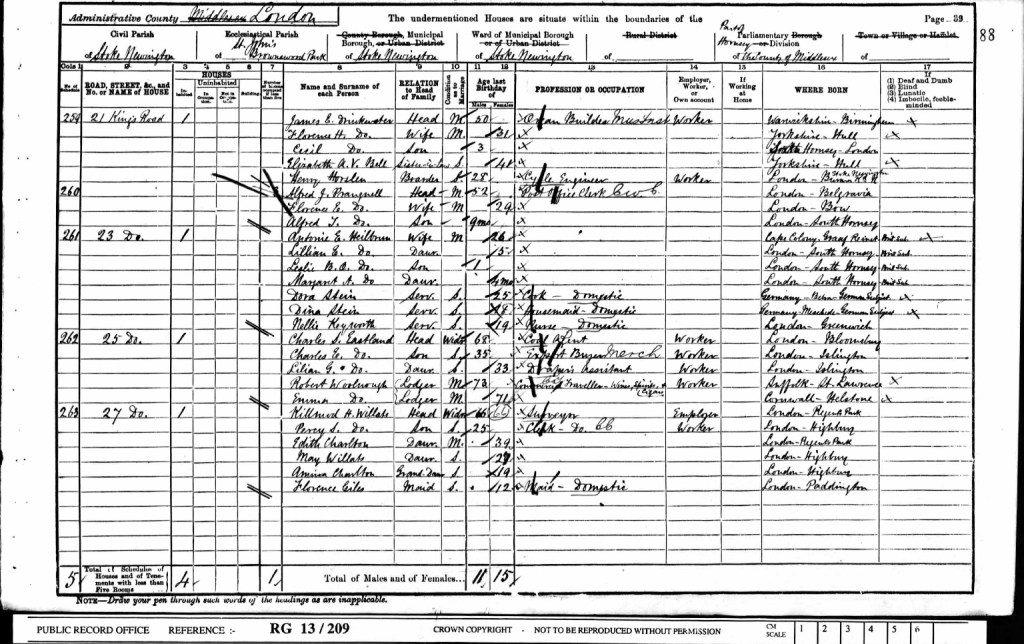
Edith’s husband Edward was staying with his brother at his home, 34, Farringdon Street, St Sepulchre Without Newgate, City of London, London, England.

And their Son Francis Henry Arthur, was residing at the home of Edith’s brother Walter James Willats.

Sadly death was once again had the Willats family firmly in its grasp. Edith’s sister, Eliza Mary Beach nee Willats died on Monday the 21st of July 1902, at Beach Court, Upper Deals, Eastry, Kent, England, at the awfully young age of 35 years. Eliza died from Pneumonia and exhaustion. Edith Cameron Charlton nee Willats, Charlotte and Eliza’s sister, was present and registered her death on the same day, Monday the 21st of July 1902. Edith stated the Eliza was the wife of Benjamin Beach, giving his profession as, independent means.

Eliza Mary Beach nee Willats, to rest on Thursday the 24th of July, 1902, at St Peter in Thanet, Kent, England.
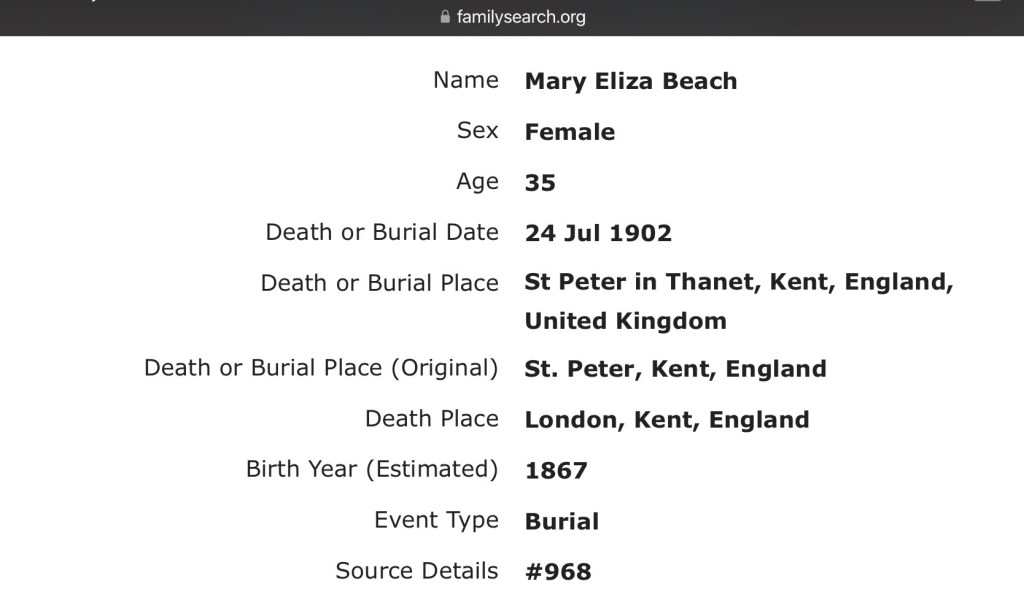
St Peter’s is an area of Broadstairs, a town on the Isle of Thanet in Kent. Historically a village, it was outgrown by the long-dominant settlement of the two, Broadstairs, after 1841. Originally the borough or manor of the church of St. Peter-in-Thanet, it was said to be the largest parish east of London, at least until Broadstairs became a separate parish on 27 September 1850. The two settlements were formally merged administratively in 1895. The village and its church, named after Saint Peter, was the second daughter church of Minster established in 1070, although the first written record of its present name dates to 1124. In 1254 the village was named “scī Petr'”, which gradually changed to “scī Petri” by 1270, Sti Petri in Insula de Thaneto by 1422, and finally settling by 1610 on its current form of St Peter’s. The church has the right to fly the white ensign, dating from when the church tower was used as a signalling station in the Napoleonic Wars. The village sign won first prize in a nationwide competition in 1920. Edward Heath, leader of the Conservative Party from 1965 to 1975, serving as prime minister from 1970 to 1974, was born in the village in 1916. On 27 April 1952, a United States Air Force Republic F-84 Thunderjet from RAF Manston crashed in the main street with loss of life.

Edith’s sister, 28-year-old, spinster, May Claretta Willats married 20-year-old, architectural florist, and bachelor, George Frederick Champion on Saturday the 4th of April 1903, at St. John’s Church, Highbury Vale, Islington, London, England. May gave her residence as, 21 Montague Road and George as, 194 Green Lands. They gave their father’s names and occupations, as George Frederick Champion, an architectural florist and Richard Henry Willats an Estate Agent. Their witnesses were, George Frederick Champion and May’s niece, Amina Eliza Catherine Charlton.

And Edith’s brother, 26-year-old bachelor, and surveyor, Frederick Howard Willats, married 24-year-old spinster Maud May Beach, on Saturday the 19th of September 1903, at St. John’s Church, Highbury Vale, Islington, London, England. Frederick gave his abode as, 27 Kings Road and Maud graves hers as, 16 Orchard Road, St. Margarets on Thames. They gave their fathers names and occupations, as Richard Henry Willats, estate agent, and Walter Beach (deceased), a Gentleman. Their witnesses were her brother, Persey Sidney Willats and his niece, Amina Eliza Catherine Charlton.

Edith and Edwards’s daughter 22-year-old spinster, Amina Eliza Katherine Charlton, married 24-year-old, bachelor, Albert Henry Joseph Reichert, on the 11th day of June 1904, at St. Johns Highbury Vale, Islington, Middlesex, England. Edith gave her abode as, number 21, Victoria Road and Albert gave his as number 18, Wyatt Road. He gave his occupation as a Clark. (please correct me if this is wrong.) They gave their fathers names and occupations as, Edward Charlton a surveyor, and Karl Martin Reichert, a confectioner, also known as Charles. Their witnesses were our very own, Edith Charlton and Edwards Father Karl Martin Reichert. As you can see the certificate isn’t very clear and holds lots of mistakes with correctional notes in the margins.
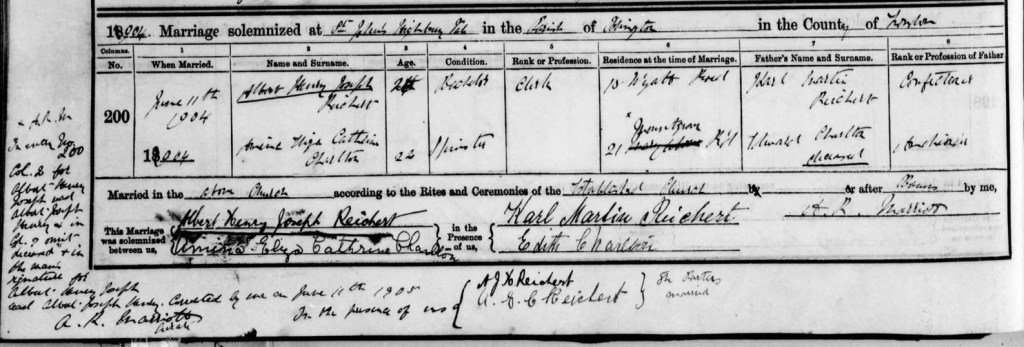
Edith’s brother, 43-year-old, widower and salesman, Arthur Charles married 30-year-old, spinster and actress, Ruth Gadsby, on the 17th of June 1908, at Niagara Falls, Welland, Ontario, Canada.

Edith’s brother, 33-year-old, bachelor, Percy Sidney Willats, married 25-year-old, spinster, Sophie Ann Smart on Saturday the 24th of July 1909 at The Register Office, Edmonton, Middlesex, England. Their witnesses were, E. P. Willats and J H Champion. Percy gave his occupation as an auctioneer. They gave their abode as Number 11 The Quadrant, Winchmore Hill, Edmonton. They gave their fathers names and occupations as, Richard Henry Willats, a auctioneer and John Smart, a Market Gardener.

The 1911 census was taken on Sunday 2nd April 1911. It shows Edith and Edward, their daughter Amina Reichert, her son-in-law Albert Reichert and her Grandson, Francis Reichert, were residing at, Number 360, Green Lanes North, Stoke Newington, London & Middlesex, England.

John and Annie Lapthorn and their 9 children were also residing there. Edward was working as a surveyor, Albert was a clerk in the stock exchange and Francis was a scholar. The census shows that Edith and Edward have been married 30 years and have had two children born alive and still living. 360, Green Lanes was an 11-room dwelling.

Edith’s sister, 43-year-old, widow, Lillian Jenny Neilson nee Willats, married 41-year-old, bachelor, George Campbell Ferris, on Saturday the 23rd of October 1915, at The Register Office, Islington, London, England. Jenny gave her abode as, 35, Yesbury Road and George gave his as 87 Winchester Street and his occupation as a commercial clark. Their parents were named as, George Coell Ferris a commercial traveler (deceased) and Richard Henry Willats, an Auctioneer. Their witnesses were, Claude Eayes and J E Bailie.

Edith’s and Edward’s daughter 36-year-old, Amina Eliza Kathleen Reichert Nee Charlton, sadly passed away on Sunday the 20th of October 1918, at Number 22 Brownwood Park, Stoke Newington, Hackney, London, England. Amina died from Bronchitis Pneumonia. Her Aunt May Claretta Champion of 27 Kings Road, Stoke Newington, was present and registered Amina’s death on Wednesday the 23rd of October 1918 in Hackney. Amina was the wife of Albert Henry Reichert Corporal 022965 Army Ordnance Corps (Stock Exchange Cleark)

Amina was laid to rest at Abney Park Cemetery, 215 Stoke Newington High Street, Stoke Newington, London, England, N16 0LH, on Saturday the 26th of October 1918, in grave 127434 possibly renumbered 17434, with Baby Crosbie, Mabel Cameron Woollet Willats, Charlotte Ellen Crosbie and Eliza Smith (Charlotte Ellen Crosbie companion).

Edith’s brother, 48-year-old, Architects Draftsman, Edwin Paul Willats, sadly passed away, on Monday the 5th of July 1920, at Number 52, Grove Park Road, Tottenham, Edmonton, Middlesex, England.

Edwin died from Pulmonary Tuberculosis and Hemoptysis cardiac failure. Certificated by Gordon Miller mb. No post-mortem was taken. Edwins sister in-law, Amelia Ellen Willats nee High, of 132, Landsdowne Road, Tottenham. A E Willats, was present and registered Edwin’s death on Tuesday the 6th of July 1920, in Edmonton.

The Willats family and friends laid Edwin Paul Willats, to rest at, Abney Park Cemetery, Stoke Newington, Hackney, London, England, in Section, D06, Index 7S03, on Saturday the 10th of July, 1920.
He was buried with other family members.

Edith’s brother, 63-year-old, Insurance Manager, Francis Montague Allan Willats, sadly passed away on Sunday the 19th of September 1920, at Wymondley Heathgate, Hendon, Middlesex, England. He died from Chronic interstitial hepatitis several years, certified by H. Stedman. No post-mortem was taken. Francis’s son, Allen Montague Willats was present and registered his death on Tuesday the 22nd of September, 1920, in Hendon.

Edith’s brother, Francis was laid to rest, on Tuesday the 21st September 1920, at Highgate Cemetery, Camden, London, England, grave reference /40479. He was buried with 7 others, Frances Jessie Willats, buried 16th September 1976. Allan Montague Willats, buried 2nd March 1968. Dorothy Beaumont Willats, buried 9th April 1965. Margaret Eliza Craddock, buried 1st January 1961. David Allan Willats, buried 5th February 1948. Margaret Jane Willats, 25th October 1937 and Horace Lennan Willats, buried 19th December 1916.

The 1921 census was taken on the 19th of June 1921. Unfortunately I have not been able to locate Edith as of yet but she wasn’t with her husband. Edward was visiting, 121, Gipsy Hill, Upper Norwood, Lambeth, London & Surrey, England. He gave his home address as, 39 Adolphine Road Finsbury Park.
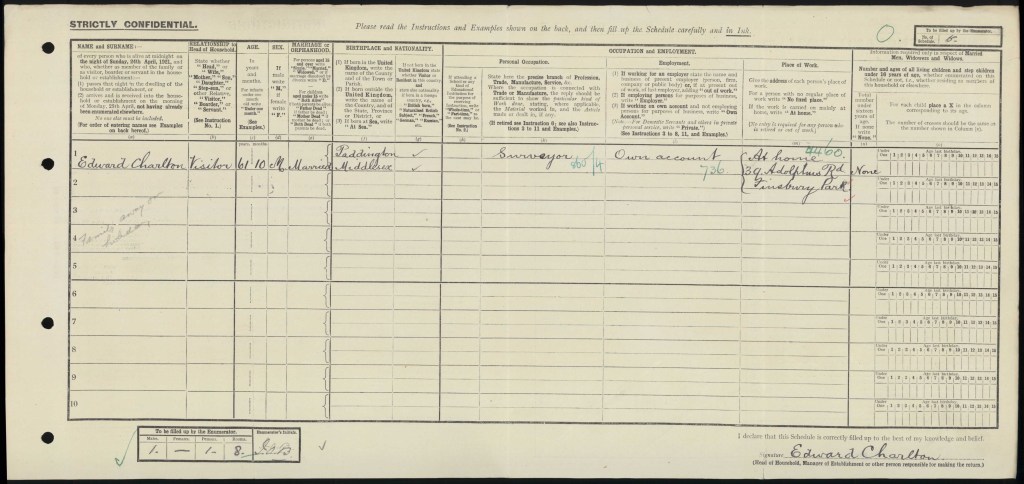
Edith’s brother, 67 years old, formerly Director of Limited Companies, Henry Richard Willats, passed away on Monday the 27th of November 1922, at 23 Barnmead Road, Beckenham, Bromley, Kent, England. Henry died from Chronic Naphritis 10 years and Cardinal Failure 6 months. Certified by Georgia R Stilwell M.B. Henry’s brother W J Willats of 132 Lansdowne Road, was in attendance and registered Henry’s death on the same day as his death, Monday the 27th of November, 1922, in Bromley.

The Willats family laid, Henry Richard Willats to rest, on Friday the 1st of December 1922, at Abney Park Cemetery, Stoke Newington, Middlesex, England. His was buried in a family grave and was buried with Baby Thornton, Florence Jose Western nee Willats, Harry Ashley Willats, William Western Thornton, and Amelia Willats.

Edith’s husband, 53-year-old, Architect, Edward Charlton, of 39 Adolphus Road, Stock Newington, sadly died on Friday the 22nd of December 1922, at The Royal Northern Hospital, Upper Holloway, Islington, London, England. Edward died from Mitral Stenosis and Myocarditis Syndrome. His wife Edith Charlton, of 39 Adolphus Road, Stock Newington, was present and registered Edward’s death on Friday the 22nd of December 1922.

Edward Charlton, was laid to rest on the 28th of December 1922, at Abney Park Cemetery, Stoke Newington High Street, Stoke Newington, Hackney, Greater London, England, in grave 092432, with Unnamed Willats, Daisy Jean Maria Willets, Constance Margaret Thora Willatts, Edwin Paul Willats and Sophie Ann Willats.

Edith’s father, 89-year-old, Richard Henry Willats sadly died, on Thursday the 22nd of November, 1923, at, 34B Portsdown Road, Paddington, London, England

Richard died from, Bronchitis and Senility, the state of being senile, down to the weakness or mental infirmity of old age. Richards son, Percy Sidney Willats of 27 Kings Road, Finsbury Park, was present and registered his fathers death on Saturday the 24th of November, 1923. Percy, gave Richards occupation as a retired, auctioneer and surveyor.

Edith and family laid her father Richard, to rest, on Tuesday the 27th of November, 1923, at Abney Park Cemetery, Stoke Newington, Hackney, London, England, in grave D06 092431 with his wife, Eliza Willats nee Cameron, his sons Francis Paul Willats and Percy Sidney Willats. And his Stepson William George Willats. (My 3rd Great-Grandfather.)

Edith’s sister, 64-year-old Charlotte Ellen Crosbie, widow of medical student, Pierce William Crosbie, sadly passed away on Saturday the 5th of April, 1924, at her home, number 34 Portsdown Road, Paddington, London, England. Charlotte died from, Cardiac Disease (mitral) and Hemiplegia. Edith, of number 27 Kings Road, Finsbury Park was present and registered her sister Charlotte’s death on Monday the 7th of April 1924 in Paddington, London, England.

Edith and family laid her sister Charlotte to rest, in April 1924, at Abney Park Cemetery, Stoke Newington, Hackney, Greater London, England, in Grave Reference – Sec. I09, Index 7S08.

Charlottes probate was granted on the 13th of June 1924, in London, England. It reads as follows,
CROSBIE Charlotte Ellen of 34b Portsdown Road Maida Vale Middle- sex widow died 5 April 1924 Probate London 13 June to Thomas George Hancock of no occupation and Walter James Willats member of stock exchange. Effects £4433 16s. 5d.

Edith inherited from Charlotte’s Last Will and Testament, which you can read about in Charlotte’s life story. Her Will is fascinating to read.
From the 1925 London, England, Electoral Registers, we know Edith was residing at Number. 163 Camden Road, St Pancras, Middlesex, England, in the year 1925.
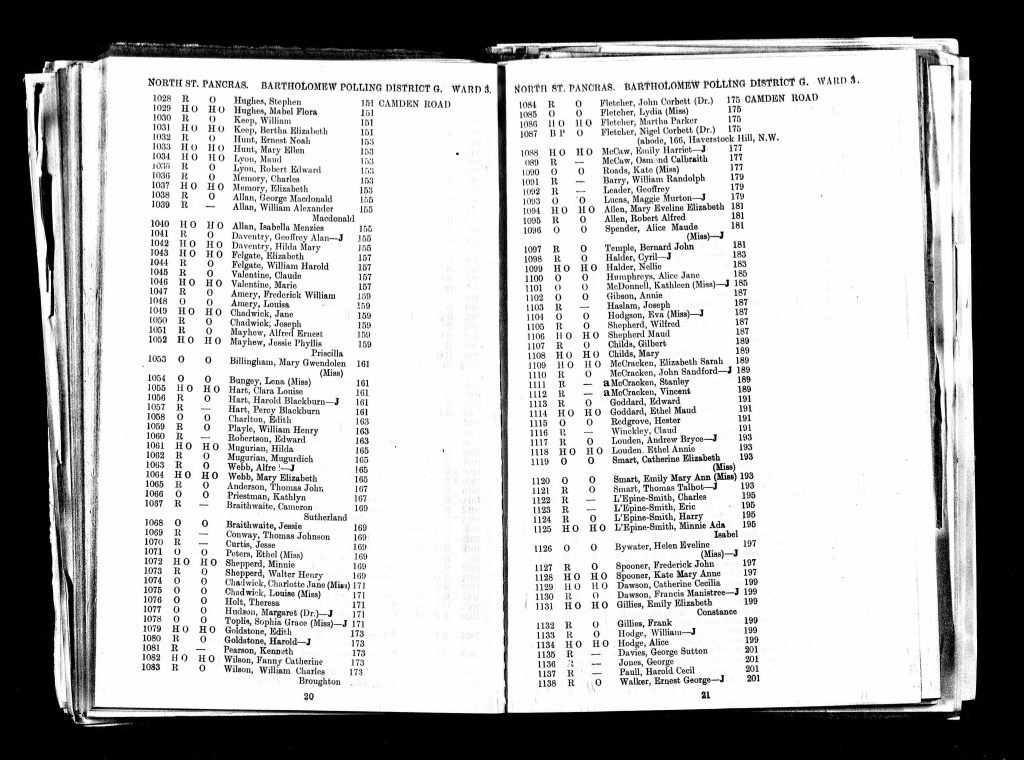
From the 1927 London Electoral Register we know Edith was residing at Number. 163 Camden Road, St Pancras, Middlesex, England, in the year 1927.

Edith’s brother 64-year-old stockbroker, Walter James Willats, passed away on Friday the 29th of March 1929, at 163 Camden Road, St Pancras, London, England. Walter died from Myocarditis, Bronchitis and Cardiac Failure. His nephew P Champion, of 163 Camden Road, St Pancras, was present and registered Walter’s death on Tuesday the 2nd of April 1929 in St Pancras, London.


Walters Grant reads as Follows,
Administration. DEATH ON OR AFTER 1st JANUARY 1898.
BE IT KNOWN that Walter James Willats – Of 163 Canden Road, Kemtish Town in the county of Middlesex
died there on the 29th day of March 1929
intestate a widower leaving Walter Richard Sidney Willats, John Tresilian Willats and Arthur Howand Cameron Willats his lawful Sons the only persons entitled to his estate who have renomeed letters of Administration of his estate
AND BE IT FURTHER KNOWN that at tbe date hereunder written Letters of Administration of all the Estate which by law devolves to and vests in the personal representative of the intestate were granted by His Majesty’s High Court of Justice at the Prinoipal Probate egistry thereof to
Ada Charlton of the above address widow a executor
of the said intestate.
Dated the 20th day of august 1929
Gross value of Estate £26 – 0 -0 –
Net value of Persomal Estate £26 – 0 -0 –

I ordered Walters Last Will and Testament but unfortunately when I went to down load it, I got this message instead.
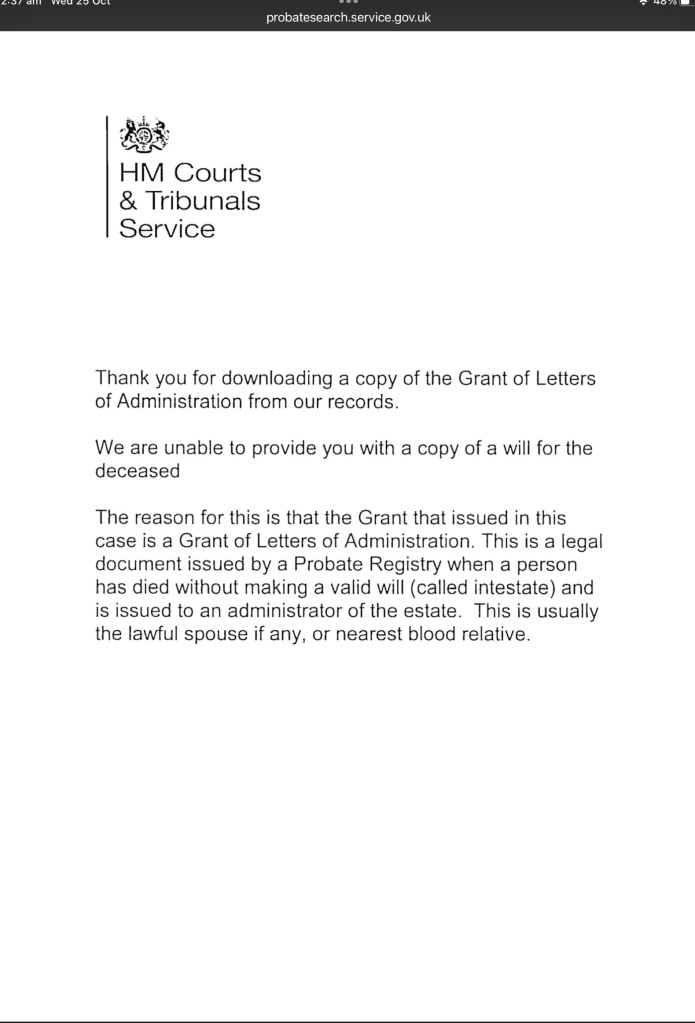
Did you notice that both Charlotte and Walter both referred to Edith as Ada in their Wills or probate?
From the 1929 London, England, Electoral Registers, we know Edith was residing at, Number 163, Camden Road, St Pancras, Middlesex, England with her Sister May Champion with her nephews Richard John Champion, Philip Frederick Champion and David George Champion, and Elizabeth May Champion.
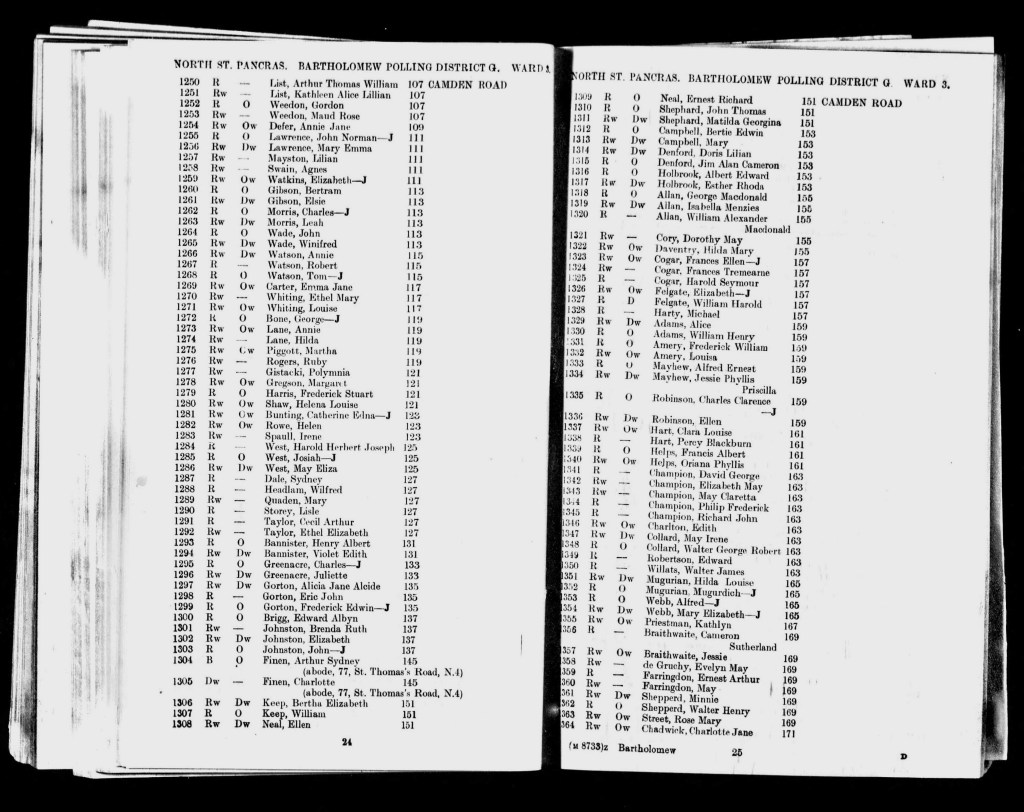
From the 1930 London Electoral Register we know Edith was residing at Number. 37a Palmerston Road, Wood Green, England, in the year 1930, with her sister May Champion with her nephews Richard Champion and David George Champion.
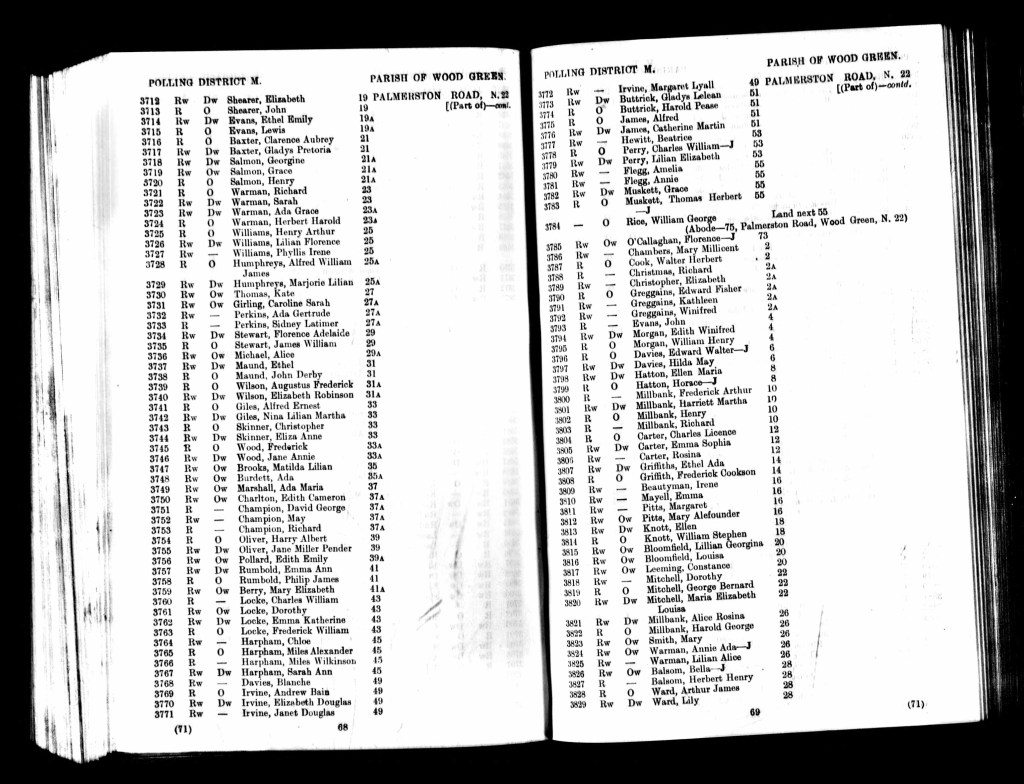
From the 1931 London Electoral Register we know Edith was residing at Number. 92a Amherst Park, Stepney, and, Stoke Newington, Middlesex, England, in the year 1931, with her nephew David George Champion.

From the 1932 London Electoral Register we know Edith was residing at Number. 92a Amherst Park, Stepney, and, Stoke Newington, Middlesex, England, in the year 1932, with her sister May Claretia Champion, her nephew David George Champion.

Edith’s brother, Arthur Charles Willats, sadly passed away on Friday the 2nd of June 1933, in Buffalo, Erie, New York, USA.

His death announcement was put in the Niagara Falls Gazette, on Friday the 2nd of June 1933. It read as follows,
ARTHUR WILLATS DIES
Buffalo Newspaperman, Lecturer, Former
Actor Succumbs to Heart Attack.
BUFFALO, June 2-Arthur C. Willats,
69 years old,’well known Buffalo
lecturer and former Shakesperian
actor, “‘died in ‘ Dr. Pierce’s Invalids
Hotel and Surgical Institute, 665 Main
street, early this morning. He had
been in the institution since suffering
aheart attack three weeks ago.
Mr. Willats was born in England
and after coming to this country at
the age of 17 he toured the United
States as an actor, settling in Buffalo
50 years ago. He was engaged
as a lecturer at the old Buffalo
Cyclorama for many years and had
been a member of the staff of the
Buffalo Evening News for 40 years.
He had also recently lectured over
the radio..
He Is survived by a son, Richard
H. Willats, Buffalo automobile distributor,
and a daughter, Mrs. Louis
G. Collard, 84 Montlcello place.
Arthur’s life is absolutely fascinating and you soon will be able to read all about it. I have spent months gathering all the information I can find. I can not believe I have the honour of calling him my 3rd great-granduncle.
From the 1933 London Electoral Register we know Edith was residing at Number. 92a Amherst Park, Stepney, and, Stoke Newington, Middlesex, England, in the year 1933 with her sister May Claretia Champion, her nephews David George Champion, and Philip Frederick Champion and Amy Elizabeth Champion.

Edith sister, 57-year-old, May Claretta Champion nee Willats, of Number 20, Blackstock Road, Islington, widow of George Frederick Champion, a chicken meat market, passed away on Thursday the 26th of July 1934, at The Royal Northern Hospital, Upper Holloway, Islington, London, England. May died from, Pyloric obstruction, gastric Ulcer, and Chronic Colitis (operation). A postmortem took place without an inquest. May’s son P. F. Champion of Number 20, Blackstock Road, Islington registered May’s death on Saturday the 28th of July 1934, in Islington.

46-year-old Edith Cameron Charlton nee Willats, the widow of Edward Charlton, Auctioneer, of Number 40, Damers Road, Hornsey, sadly passed away on Thursday the 21st of April 1938, at Hornsey Central Hospital, Park Road, Hornsey, Edmonton, Middlesex, England. Edith died from, Post Operative Shock, Operation Osphorectiny, Ovarian Cyst and Cardio Vascular Degeneration. Edith’s nephew, Philip F. Champion of number 4, Crescent Road, Crouch End, registered her death on Friday the 22nd of April 1938.

Hornsey Cottage Hospital, later Hornsey Central Hospital, was a local hospital in Crouch End, North London, opened in 1910. It closed in 2001, and was replaced by a polyclinic in 2009. A proposal for a ‘hospital for the poor’ was first made in 1897. Local fund raising eventually led to construction of the Hornsey Cottage Hospital on land provided by the Ecclesiastical Commissioners. The foundation stone was laid in 1907. Opening in 1910, the original hospital had sixteen beds. Following the First World War a war memorial was built at the site, to commemorate 1,200 people from the borough who had died in the war. In 1924 the building was expanded, with a further 22 beds and a new operating theatre. In 1927 a further small extension was made and it was renamed as Hornsey Central Hospital. A nurses’ home was added in 1930 and a children’s ward (the Southwood Wing) in 1938. After the introduction of the National Health Service in 1948, the hospital was administered by the North West Metropolitan Regional Hospital Board. A further extension was made in 1956. The site continued as a general hospital until 1974, when it specialised in acute cases. In 1981 it became a geriatric hospital, providing long-term care for the elderly. In 1998 the local health authority decided that the hospital could no longer provide modern health care and it closed in 2001. The hospital was subsequently demolished and redeveloped as the Hornsey Central Neighbourhood Health Centre. The war memorial was retained.

Sadly I haven’t as yet, discovered the location of Edith’s last resting place. She isn’t on the list of Willats who were laid to rest at Abney Park Cemetery. May and Walters locations are proving tricky to find also. I will of course update you when I discover their resting places.
As the sun sets upon Edith Cameron Charlton’s life, the echoes of her journey resonate through the corridors of time. Born in the heart of Marylebone, amidst the embrace of an expansive and affluent family, Edith’s story unfolded against the backdrop of a world in metamorphosis. Her footsteps, once so delicate on the cobblestone streets, now leave an indelible mark on the annals of our family’s history. Edith’s life, woven with threads of opulence and privilege, carried with it a grace that touched all who were fortunate enough to know her essence. Through eras of change and shifting tides, in the quiet borough of Hornsey, London, where her journey on this earthly plane drew to a close in 1938, we find solace in knowing that her legacy endures. Edith’s spirit lives on in the stories we pass down, in the love that unites us, and in the lessons of grace and resilience Edith and her fascinating family bestowed upon us all. As we bid adieu to this luminous soul, let us carry forward the torch of her legacy. May her legacy be a guiding light, reminding us of the strength that dwells within us, urging us to embrace life’s joys and weather its storms with the same grace that she exemplified. In her memory, let us treasure each passing moment, knowing that the echoes of her life continue to dance in the chambers of our hearts.
Rest in peace, dear Edith. Your light continues to shine, illuminating the path for generations to come.
Rest Peaceful,
Edith Cameron Charlton nee Willats
1861-1938
Until next time, Toodle pip.

🦋🦋🦋
I have brought and paid for all certificates,
Please do not download or use them without my permission.
All you have to do is ask.
Thank you.
Fascinating well done your research is amazing
LikeLike